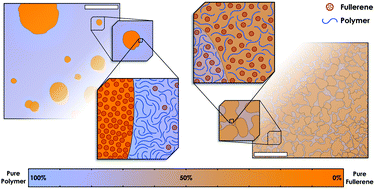Unravelling donor–acceptor film morphology formation for environmentally-friendly OPV ink formulations†
Abstract
The challenge of coating organic photovoltaics (OPV) from green solvents is to achieve the required nanostructured interpenetrating network of donor and acceptor domains based on a rational choice of solvent approach as opposed to the usual trial-and-error methods. We demonstrate here that we can achieve a bicontinuous interpenetrating network with nanoscale phase separation for the chosen donor–acceptor material system poly[2,3-bis-(3-octyloxyphenyl)quinoxaline-5,8-diyl-alt-thiophene-2,5-diyl]:phenyl-C61 butyric acid methyl ester (TQ1:PC61BM) when processing from green solvent ink formulations. This structure is achieved by first calculating the Hansen solubility parameters (HSP) of the donor and acceptor materials, followed by careful choice of solvents with selective relative solubilities for the two materials based on the desired order of precipitation necessary for forming a nanostructured interdigitated network morphology. We found that the relative distances in Hansen space (Ra) between TQ1 and the primary solvent, on the one hand, and PC61BM and the primary solvent, on the other hand, could be correlated to the donor–acceptor morphology for the formulations based on the solvents d-limonene, anisole, and 2-methyl anisole, as well as the halogenated reference solvent o-dichlorobenzene. This nanostructured blend film morphology was characterised with scanning transmission X-ray microscopy (STXM) and transmission electron microscopy (TEM), and the film surface composition was analysed by near edge X-ray absorption fine structure (NEXAFS) spectroscopy. Hansen solubility theory, based on solution thermodynamics, has been used and we propose an HSP-based method that is a general platform for the rational design of ink formulations for solution-based organic electronics, in particular facilitating the green solvent transition of organic photovoltaics. Our results show that the bulk heterojunction morphology for a donor–acceptor system processed from customised solvent mixtures can be predicted by the HSP-based method with good reliability.



 Please wait while we load your content...
Please wait while we load your content...